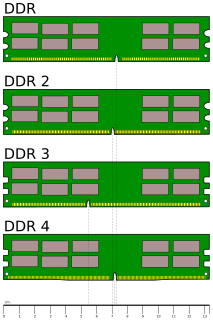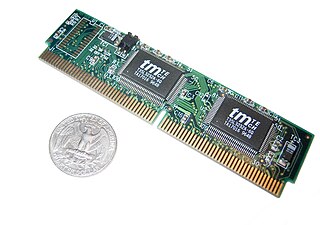
Double Data Rate Synchronous Dynamic Random-Access Memory is a double data rate (DDR) synchronous dynamic random-access memory (SDRAM) class of memory integrated circuits used in computers. DDR SDRAM, also retroactively called DDR1 SDRAM, has been superseded by DDR2 SDRAM, DDR3 SDRAM, DDR4 SDRAM and DDR5 SDRAM. None of its successors are forward or backward compatible with DDR1 SDRAM, meaning DDR2, DDR3, DDR4 and DDR5 memory modules will not work in DDR1-equipped motherboards, and vice versa.

The Intel 386, originally released as 80386 and later renamed i386, is a 32-bit microprocessor introduced in 1985. The first versions had 275,000 transistors and were the CPU of many workstations and high-end personal computers of the time. As the original implementation of the 32-bit extension of the 80286 architecture, the i386 instruction set, programming model, and binary encodings are still the common denominator for all 32-bit x86 processors, which is termed the i386-architecture, x86, or IA-32, depending on context.

The Intel 486, officially named i486 and also known as 80486, is a higher-performance follow-up to the Intel 386 microprocessor. The i486 was introduced in 1989 and was the first tightly pipelined x86 design as well as the first x86 chip to use more than a million transistors, due to a large on-chip cache and an integrated floating-point unit. It represents a fourth generation of binary compatible CPUs since the original 8086 of 1978.

In computing, an expansion card is a printed circuit board that can be inserted into an electrical connector, or expansion slot on a computers motherboard, backplane or riser card to add functionality to a computer system.

AVR is a family of microcontrollers developed since 1996 by Atmel, acquired by Microchip Technology in 2016. These are modified Harvard architecture 8-bit RISC single-chip microcontrollers. AVR was one of the first microcontroller families to use on-chip flash memory for program storage, as opposed to one-time programmable ROM, EPROM, or EEPROM used by other microcontrollers at the time.

A DIMM or dual in-line memory module, commonly called a RAM stick, comprises a series of dynamic random-access memory integrated circuits. These modules are mounted on a printed circuit board and designed for use in personal computers, workstations, printers, and servers. DIMMs began to replace SIMMs as the predominant type of memory module as Intel P5-based Pentium processors began to gain market share.

The Personal System/2 or PS/2 is IBM's third generation of personal computers. Released in 1987, it officially replaced the IBM PC, XT, AT, and PC Convertible in IBM's lineup. Many of the PS/2's innovations, such as the 16550 UART, 1440 KB 3.5-inch floppy disk format, Model M keyboard layout, 72-pin SIMMs, the PS/2 port, and the VGA video standard, went on to become standards in the broader PC market.

A SIMM is a type of memory module containing random-access memory used in computers from the early 1980s to the early 2000s. It differs from a dual in-line memory module (DIMM), the most predominant form of memory module since the late 1990s, in that the contacts on a SIMM are redundant on both sides of the module. SIMMs were standardised under the JEDEC JESD-21C standard.
The Serial Peripheral Interface (SPI) is a synchronous serial communication interface specification used for short-distance communication, primarily in embedded systems. The interface was developed by Motorola in the mid-1980s and has become a de facto standard. Typical applications include Secure Digital cards and liquid crystal displays.

The DECstation was a brand of computers used by DEC, and refers to three distinct lines of computer systems—the first released in 1978 as a word processing system, and the latter two both released in 1989. These comprised a range of computer workstations based on the MIPS architecture and a range of PC compatibles. The MIPS-based workstations ran Ultrix, a DEC-proprietary version of UNIX, and early releases of OSF/1.

COASt, an acronym for "cache on a stick", is a packaging standard for modules containing SRAM used as an L2 cache in a computer. COASt modules look like somewhat oversized SIMM modules. These modules were somewhat popular in the Apple and PC platforms during early to mid-1990s, but with newer computers cache is built into either the CPU or the motherboard. COASt modules decoupled the motherboard from its cache, allowing varying configurations to be created. A low-cost system could run with no cache, while a more expensive system could come equipped with 512 KB or more cache. Later COASt modules were equipped with pipelined-burst SRAM.

A SO-DIMM or small outline dual in-line memory module, is a type of computer memory built using integrated circuits. A SO-DIMM is a smaller alternative to a DIMM, being roughly half the physical size of a regular DIMM.

The FM Towns is a Japanese personal computer, built by Fujitsu from February 1989 to the summer of 1997. It started as a proprietary PC variant intended for multimedia applications and PC games, but later became more compatible with IBM PC compatibles. In 1993, the FM Towns Marty was released, a game console compatible with existing FM Towns games.
In computing, serial presence detect (SPD) is a standardized way to automatically access information about a memory module. Earlier 72-pin SIMMs included five pins that provided five bits of parallel presence detect (PPD) data, but the 168-pin DIMM standard changed to a serial presence detect to encode much more information.

The SPARCstation 20 or SS20 is a discontinued Sun Microsystems workstation introduced in March 1994 based on the SuperSPARC or hyperSPARC CPU. It is one of the last models in the SPARCstation family of Sun "pizza box" computers, which was superseded by the UltraSPARC design in 1995.
Sound Blaster Advanced Wave Effects 64 ISA sound card from Creative Technology. It is an add-on board for PCs. The card was launched in November 1996.

DEC 3000 AXP was the name given to a series of computer workstations and servers, produced from 1992 to around 1995 by Digital Equipment Corporation. The DEC 3000 AXP series formed part of the first generation of computer systems based on the 64-bit Alpha AXP architecture. Supported operating systems for the DEC 3000 AXP series were DEC OSF/1 AXP and OpenVMS AXP.

In computing, a memory module or RAM stick is a printed circuit board on which memory integrated circuits are mounted. Memory modules permit easy installation and replacement in electronic systems, especially computers such as personal computers, workstations, and servers. The first memory modules were proprietary designs that were specific to a model of computer from a specific manufacturer. Later, memory modules were standardized by organizations such as JEDEC and could be used in any system designed to use them.
The DEC 4000 AXP is a series of departmental server computers developed and manufactured by Digital Equipment Corporation introduced on 10 November 1992. These systems formed part of the first generation of systems based on the 64-bit Alpha AXP architecture and at the time of introduction, ran Digital's OpenVMS AXP or OSF/1 AXP operating systems.
Double Data Rate 4 Synchronous Dynamic Random-Access Memory is a type of synchronous dynamic random-access memory with a high bandwidth interface.















